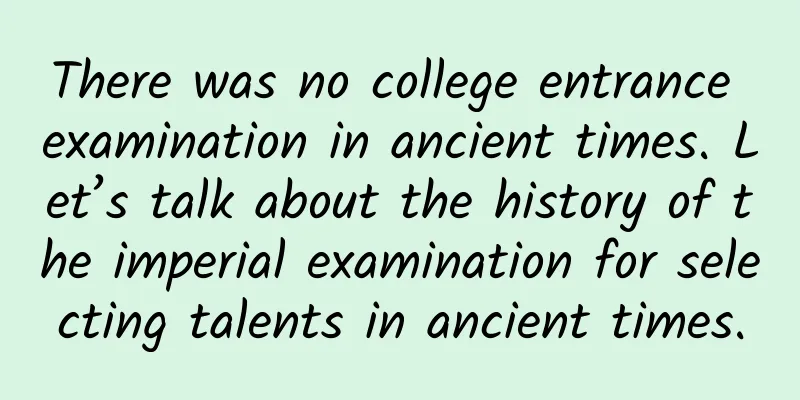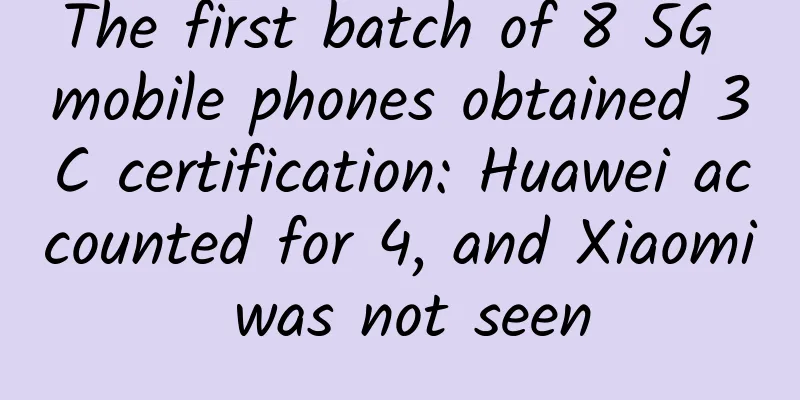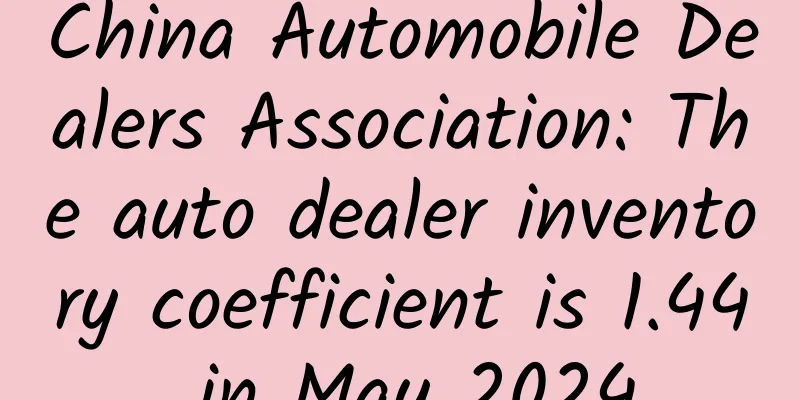There was no college entrance examination in ancient times. Let’s talk about the history of the imperial examination for selecting talents in ancient times.

|
When it comes to "college entrance examination" It always reminds me of countless hard nights. Thinking of the endless test papers For every high school student They are all indelible memories Back to ancient times For students who study hard The imperial examination is the ultimate goal This is also the broad road for countless poor people to change their destiny. In this issue, we look back to the past Let’s talk about the thousand-year history of the ancient imperial examination~ Aristocratic monopoly and the creation of the imperial examination system "The key to governing is to get the right people" and "cultivating talents is the foundation of the country". All dynasties in my country have attached great importance to the selection and management of officials. When it comes to the selection of officials, we cannot fail to mention the imperial examination system. It originated in the Sui and Tang Dynasties, flourished in the Song Dynasty, and lasted until the Qing Dynasty. It has a history of more than 1,300 years, which can be said to be the longest official selection system in history. The talent selection methods before the imperial examination system were mainly the hereditary system of the Western Zhou Dynasty, the recommendation system of the Han Dynasty, and the nine-rank system of the Wei, Jin, Southern and Northern Dynasties. These systems often encountered the same problem in practice, that is, selecting people based on family background. Take the Nine-Rank System as an example. It was originally intended to correct the phenomenon of "name does not match reality" caused by the recommendation system. It set up "Zhongzheng" as "representatives of public opinion" to select talents. However, the aristocratic families controlled the society from the bottom, and the selection of talents became a tool for the aristocratic families to manipulate, which led to "no poor family in the upper ranks, no aristocratic family in the lower ranks", and the ranks of officials were inbred. The organizational power, control and influence of these aristocratic families on society were actually greater than that of the court, which was very unfavorable to the centralization of power. During the Kaihuang period, Emperor Wen of Sui abolished the Nine-Rank System, and "near the time of Emperor Yang of Sui, the Jinshi category was established," thus creating the imperial examination system. Sui and Tang Dynasties: The Beginning of the Imperial Examination Era "Viewing the List" | Source: China Treasure Museum official website In the Sui and Tang dynasties, the imperial examinations were set up to recruit candidates regardless of family background, region, industry, etc., which created a tradition of selecting people regardless of their background. First, regardless of family background. In response to the problem that under the recommendation system, "there were no poor families in the upper ranks and no powerful families in the lower ranks", the children of the gentry became officials and served for generations, and the social class was solidified, the imperial examination system broke the concept of family background and allowed poor people to enter. The purpose of the imperial examination in the Tang Dynasty was to select talented people. No matter "people of low status" or "children of low status", anyone could apply for the examination freely, making it possible to "become a common man in the morning and a minister in the evening", thus breaking the barriers of social classes since the Wei and Jin Dynasties. Prime ministers and Emperor Wenzong such as Li Yifu, Guo Zhengyi, Zhang Jiuling, and Han Yu all came from humble backgrounds and changed their fate through the imperial examination. The imperial examinations in the Tang Dynasty mainly tested the two subjects of "Mingjing and Jinshi". The Mingjing subject mainly tested the recitation of scriptures, which was similar to the form of reciting famous sentences in the college entrance examination. In addition, a passage from the scriptures was given, and candidates were asked to analyze and discuss it in combination with actual politics. The Jinshi subject was even more difficult. This subject required students to answer five questions about current affairs, recite part of the "Book of Rites" or "Zuo Zhuan", and finally write a poem and an fu. Candidates needed to be proficient in scriptures, history, literature, and current affairs. At the same time, they had extremely high requirements for literary literacy and needed to be proficient in rhyme and rhythm to have a chance to stand out. However, passing the Jinshi exam only qualified one to be an official and got a ticket to the official career. Only after passing the examination of the Ministry of Personnel could one be officially granted an official position. The official selection examination was hosted by the Ministry of Personnel under the Ministry of Shangshu, and was called the Ministry of Personnel Examination. It was divided into four aspects: "body, speech, writing, and judgment", that is, to examine whether the body is sturdy, whether the speech is correct, whether the calligraphy is beautiful, and whether the writing is good. Only after passing all four aspects could one take off the white shirt and put on the official uniform, so the Ministry of Personnel Examination was also called the "Shihe Examination". At first, the imperial examinations in the Tang Dynasty restricted the children of corrupt officials and merchants from participating in the examinations, but in the middle and late Tang Dynasty, this restriction was gradually broken. The imperial examinations became the most effective way for the children of poor families and merchants to study and change their family backgrounds. Even the children of the gentry had to participate in the imperial examinations to maintain their family status. In addition, the Tang Dynasty's imperial examinations did not consider regional origins, fully taking into account the vast territory and the cultural differences between regions. The government allocated quotas to each prefecture and state according to factors such as cultural level and population size, in order to take care of the examination qualifications of candidates from remote and backward areas and attract talents from all over the world. But in general, the imperial examination system during the Sui and Tang dynasties still had some drawbacks of the previous system of recommendation and selection, and bureaucrats and dignitaries always interfered in it. Song Dynasty: Improvement of the Imperial Examination System Song Dynasty: "Song Ren Liutang Reading Page" (partial) Image source: The Palace Museum official website In the Song Dynasty, Emperor Taizu Zhao Kuangyin learned from the experience and lessons of the late Tang Dynasty and the Five Dynasties and carried out key reforms on the imperial examination system. The reforms adapted to the needs of social politics, and with appropriate measures and a long period of persistence, the imperial examination system gradually became perfect. Many talents emerged in the Northern Song Dynasty. During the reign of Emperor Renzong alone, there were Fan Zhongyan, Ouyang Xiu, Sima Guang, Wang Anshi, the Su brothers, Shen Kuo, etc., which was not unrelated to the relatively standardized imperial examination system at that time. In the early Song Dynasty, the imperial examination subjects were divided into Jinshi subjects, as well as various specialized subjects such as the Nine Classics, the Five Classics, Kaiyuan Li, the Three Histories, the Three Rites, and the Mingjing, in order to select professional talents. In addition, there was a special examination called "Zhi Ke". Among them, the Jinshi subject was the most important, and the number of admitted candidates was the largest. Later, Wang Anshi abolished all subjects, retaining only the Jinshi subject and the Zhike, and established the Xinming Law subject to select judicial officials. The examination is generally divided into three levels: prefectural examination, provincial examination and palace examination. The prefectural examination is held in various places, and the candidates who pass it are called "juzi" or "gongsheng". They gather in the capital in the winter of that year and take the "provincial examination" in the early spring of the following year. The provincial examination is named after the Shangshu Province and is hosted by the Ministry of Rites. The palace examination is actually a re-examination of the provincial examination. It is held in the palace and is hosted and ranked by the emperor himself. What exactly is tested? The imperial examinations in the Song Dynasty had a wide variety of topics. Taking the Jinshi exam as an example, although the subjects of the provincial examinations have changed many times, there are four subjects that are required: poetry, fu, classics, essays, and strategies. Poetry and fu and classics are easy to understand, while strategies and essays allow everyone to talk about their own views and thoughts on some historical stories and national policies. For example, Ouyang Xiu once asked a test question like this: "During the restoration of Emperor Xuan of Han, Bing Ji and Wei Xiang were prime ministers. Later generations would always refer to them when talking about wise prime ministers, so it is reasonable that they had made great achievements and were famous in the world. But when we look at their biographies, there are no other merits or virtues. There is only one chapter called 'Mingtang Yueling', which contains a brief account of their good deeds. Those who do not know why Bing and Wei were regarded as wise by later generations, how can they be seen?" - Probably during the time of Emperor Xuan of Han, Bing Ji and Wei Xiang were prime ministers. Why were they called famous prime ministers by later generations? Ming and Qing Dynasties: Rigidity, Decline, and Abolition Bronze mirror of the Ming Dynasty champion|Photo courtesy Wuzhi County Museum Due to the times, the most profound impression we have of the imperial examination system in the Ming and Qing dynasties is the eight-part essay. The eight-part essay is indeed very important in the imperial examinations of the Ming and Qing dynasties, but it is not the only criterion for the imperial examinations. Especially after entering the palace examination, the emperor did not ask for eight-part essays, but for policy essays. In other words, it is useless if you only know eight-part essays. Officials in the Ming and Qing dynasties were definitely not just examination machines, they at least had to have a certain logic in governing the country. The reason why the eight-part essay is called the eight-part essay is that the whole essay consists of eight parts: the opening, the continuation, the beginning, the introduction, the beginning, the middle, the last and the end. The eight-part essay needs to strictly follow the "Four Books and Five Classics" and narrate the problem in the tone of Zhu Xi. It mainly relies on Zhu Xi's "Four Books and Five Classics" and other contents to write articles. Due to too many restrictions, it has been criticized as a manifestation of institutional rigidity. Questions for the Jiangnan County Examination in the Ninth Year of Tongzhi in the Qing Dynasty|Photo courtesy of Taicang Museum Of course, the eight-part essay was usually the first test in the imperial examinations of the Ming and Qing dynasties. If the eight-part essay failed, the examiner would basically not read the following essays. But in fact, the eight-part essay is just a stepping stone. There are many more tests such as essays, judgments, and cases. This is just like our college entrance examination. Mathematics is very important, but you must not only do well in mathematics. If you are not good at Chinese and English, you will not go far. The imperial examination was divided into the prefectural examination, the provincial examination, the metropolitan examination and the palace examination. The first three examinations required eight-part essays. If you passed the prefectural examination, you would be a scholar. If you passed the provincial examination, you would be a juren. If you passed the metropolitan examination, you would be a jinshi. After passing the metropolitan examination, you would enter the last stage, which was the palace examination. The plaque "The purpose is to use it for teaching" in the Qing Dynasty|Source: China Imperial Examination Museum This plaque celebrates Zhang Zhaoqin's achievement in the Guangxu Wuxu Examination (1898). He ranked fifth in the second class of the imperial examination and was awarded a teaching position. Later, the Qing dynasty imitated the Ming dynasty system to hold the imperial examination, which eventually became the core of the Qing dynasty's official appointment method. It gradually became a rigid model, and especially in the late Qing dynasty, it had become a shackle that severely bound intellectuals, exposing various drawbacks. After the 1880s, with the spread of Western learning and the development of the Westernization Movement, the imperial examination system changed. In 1888, the Qing government allowed the establishment of mathematics as a subject for the examination, which included natural sciences in the examination content for the first time. Later, a special subject of economics was added to recommend talents who could handle economic changes. At the same time, in response to the suggestions of Kang Youwei and others, the eight-part essay was abolished and replaced with policy essays, with current affairs as the topic. In 1905, Yuan Shikai and Zhang Zhidong petitioned to stop the imperial examination system in order to promote the development of schools and encourage practical learning. The Qing government then announced that starting from 1906, all provincial examinations would be stopped, and the annual provincial examinations would also be stopped. Since then, the imperial examination system has been eliminated from the historical stage forever. In short, whether it is the imperial examination or the modern college entrance examination, we must understand and think about their value and significance from a historical perspective. With the continuous progress of society and the continuous innovation of education, today's college entrance examination system will pay more attention to the examination of the comprehensive quality and ability of candidates. Sources: Guangming Online: "The Impact of the Establishment of the Imperial Examination System on the Reform of the Official Selection System" The Paper, "The Imperial Examination System of the Qing Dynasty: From Development to a Dead End" Xinhua News Agency, "The Wisdom of Ancient Chinese Governance ③ Imperial Examination System: The Longest Official Selection System in History" The Paper: "The Ming Dynasty's imperial examination system relied solely on eight-legged essays? The final stage of the palace examination was the key" Image sources: China Treasure House official website, Palace Museum, China Imperial Examination Museum, Taicang City Museum, Wuzhi County Museum Source: Chongqing Jiulongpo District Cultural Relics Management Office Audit expert: Tian Junying Statement: Except for original content and special notes, some pictures are from the Internet. They are not for commercial purposes and are only used as popular science materials. The copyright belongs to the original authors. If there is any infringement, please contact us to delete them. |
>>: New blood test method: A sharp eye for identifying Alzheimer's disease
Recommend
Are “fast-thinking” programmers better?
A few days ago, an article on Hacker News titled ...
Another huge step forward! OpenAI o1 is here. How does it solve complex problems?
Produced by: Science Popularization China Author:...
China Automotive Research Institute: China's automotive industry 2019 summary and 2020 outlook report
Macro comprehensive analysis 2020 is a critical y...
Dopamine VS endorphins, which one brings true happiness?
If you are also a heavy patient of short videos, ...
The Summer Palace (Hao Lei) Baidu cloud download, The Summer Palace Hao Lei high definition and uncut!
The film tells the story of the love-hate entangl...
Moon: Earthlings, I live much longer than you think!
In the imagination of ancient people Chang'e ...
The third batch of astronauts will enter the Tiangong Space Station. How are Chinese astronauts selected?
On May 30, 2023, the successful launch of the She...
Japanese companies have been involved in emissions scandals, and Japanese media revealed how to test car fuel efficiency
Recently, according to media reports, after Mitsu...
Douyin 0-cost project: single-day income of 500, no posting of works, no account maintenance
One question that has always been mentioned in th...
Be sure to read Apple’s ASM search bidding advertising content policy regulations!
In the early morning of September 29, exactly thr...
A guide for preventing insults in self-media, you will regret not having read this book when you need it!
How to “prevent scolding”? Generally speaking, it...
Only one paper in 6 years! He drew a "family tree" for the Boletaceae family...
Drawing a "family tree" for the Boletac...
The reason for Baidu's bidding account being suspended was suspected of privacy theft. What does batch rejection mean?
(1). This may be because Baidu has detected some ...
Lamborghini Urus to be launched in China in 2018, will launch its first plug-in hybrid car
According to foreign media reports, Lamborghini&#...









